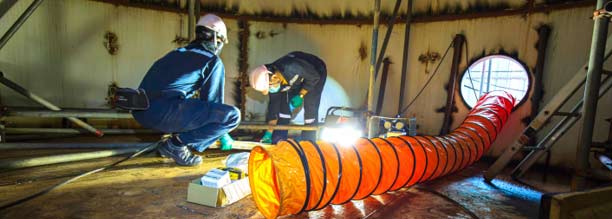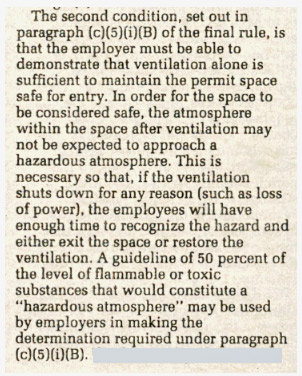
Blog Post #20 – Some permit-required confined spaces qualify to be entered under the alternate entry procedures listed in 1910.146(c)(5) of the general industry standards for permit-required confined spaces, and in 1926.1203(e) of the confined spaces in construction standards. These procedures, which allow entry into permit spaces that contain only atmospheric hazards which the employer demonstrates can be sufficiently controlled with forced air ventilation alone, differ from those discussed in the previous blog post, which explained how and when you can temporarily reclassify a permit space to non-permit space status.
The advantages to utilizing the alternate entry procedures listed in section 1910.146(c)(5) and 1926.1203(e) are that once the permit space has been certified as safe for entry under these procedures, the following elements of a full permit entry are not required:
- No written confined space entry procedure or entry permit is required for workers to enter the space, only a brief written certification;
- It is not mandatory to have an attendant stand by the entry point to the confined space during entry operations;
- Workers in the space do not have to receive the extensive training required for a permit space entrant;
- No entry supervisor is required to oversee all entry operations during alternate entry procedures; and,
- A confined space rescue team is not required to be on standby during this entry.
As you can see, the benefits of utilizing these alternate confined space entry procedures, when allowed, can make entry into eligible spaces quicker and more cost-effective, while still maintaining a safe work environment for entrants.
When do the OSHA Alternate Entry Procedures for Permit-required Confined Spaces Apply?
The OSHA 1910 general industry confined space standards for alternate entry, which were published in the early 1990’s, state that they apply to permit spaces with actual or potential atmospheric hazards only, and in which continuous forced air ventilation alone can maintain the atmosphere inside the space safe for entry. The wording of this general industry standard does not make it clear if that means the space must never present any non-atmospheric (physical) hazards at any time (pre and post entry) to qualify for entry under the alternate procedures, or if any such hazards must simply be addressed before entry is allowed.
Fortunately, the wording of the 1926 confined spaces in construction standard rule differs slightly, clarifying that alternate entry procedures can be utilized in those permit spaces where continuous, forced air ventilation can maintain the atmosphere inside the confined space safe for entry, and all other unsafe conditions (if any) which are non-atmospheric in nature are eliminated or isolated before the cover on the space is removed.
Recall that in the previous blog post, we explained OSHA’s definition of the term “isolation,” which means the process by which a permit space is removed from service and completely protected against the release of energy and material into the space.
Defining “Safe for Entry” in the OSHA Alternate Entry Standards
As stated above, these alternate entry procedures both require that continuous, forced air ventilation can maintain the atmosphere inside the confined space “safe for entry.” However, neither standard define what that term means.
Fortunately, the preamble to the 1910 general industry standard (see accompanying excerpt from page 4488 of Federal Register / Volume 58, No. 9) sheds some light on the meaning of this terminology.

This particular section of the Federal Register states that the atmospheric hazards must remain at no more than one-half (50%) their regulated levels to be considered “safe for entry” when using the alternate entry procedures.
So, as an example, flammable gas in the atmosphere is considered hazardous by Federal OSHA when it exceeds 10% of its LEL, so “safe for entry” would be an atmosphere maintained by forced air ventilation at levels not exceeding 5% LEL. And the Federal OSHA PEL for carbon monoxide is 50 ppm, so “safe for entry” would be an atmosphere containing no more than 25 ppm CO. Note: some State Plan OSHA programs have lower PELs for certain atmospheric hazards such as CO; refer to state regulations when applicable to your workplace.
Requirements for Forced Air Ventilation Utilized During Alternate Entry Operations
When using the alternate entry procedure, forced air ventilation (e.g. a hose blower or similar ventilation equipment), must be installed and operating efficiently and continuously before and throughout entry. The blower hose must be directed to ventilate the immediate areas where an employee is present, or will be present, within the space, and must continue to operate until all employees have exited the space.
The ventilation system should provide an adequate volume of air needed to allow enough time for all entrants to escape the confined space without overexposure should the ventilation system unexpectedly stop working. Determining what would be an adequate time for escape, in turn, is a function of the concentration the contaminant, the rate of generation or introduction of the contaminant into the space, and the distance to the exit. Because of the complexities of making such an evaluation, only a technically qualified person should make this determination.
Also, the employer must ensure the source of make-up air for ventilation equipment is clean and safe. So, make sure there are no sources of contamination, such as open drums of hazardous chemicals or pieces of equipment with an internal combustion engine running near the air intake of any confined space ventilation equipment.
Additional Requirements When Utilizing OSHA Alternate Entry Procedures
There are a few additional conditions that must be met if an employer chooses to utilize the alternate entry procedures listed in both OSHA confined space standards, including making sure other unsafe conditions are eliminated or isolated before the cover on the space is removed. This could include measures such as making certain to bleed off any pressure that may have built up inside of a confined space before opening the lid or removing its cover, where applicable, as the pressure could cause the lid or cover to fly off and strike someone.
Also, once the lid or cover has been removed, the opening into the space being entered under alternate procedures must be immediately guarded so that no person or object can fall into the confined space, where applicable. Devices such as portable barricades with toe-boards are available to help meet this requirement.
Then, the internal atmosphere in the space must be tested before entry using a calibrated, direct reading instrument, for oxygen, LEL, and toxics, in that order (the reason for using this specific testing order will be explained in a later blog post about atmospheric testing). Atmospheric testing is necessary to determine that the atmosphere inside the space is “safe for entry” before entry operations, and additional testing must be conducted as needed throughout entry to ensure the atmosphere is maintained. Furthermore, the employer must develop and maintain adequate monitoring and inspection data that demonstrates the ventilation system can maintain the atmosphere at safe levels throughout entry.
In those instances where it is necessary for a worker to conduct initial atmospheric testing or isolate a physical hazard from inside the space, this initial entry must be made under a full entry permit program until the hazards are isolated and the atmosphere has been deemed safe for entry.
Moreover, any activities carried out within or outside of the space must not create new atmospheric (or non-atmospheric) hazards. This includes introducing into the space any hazardous amounts of flammable or toxic substances, or performing hot work within the space, as they could introduce risks that were not considered when determining that the atmosphere inside the confined space is safe for entry.
Finally, if any hazardous atmosphere is detected during entry during alternate entry procedures, all entrants must immediately evacuate the confined space. Then the entry employer must make certain to reevaluate the space to determine why the hazardous atmosphere developed, and then implement adequate corrective measures to protect employees before any subsequent entry takes place.
OSHA Requirements for Safe Entry and Egress of Personnel
Employers must also provide a safe method of entering and exiting the space during alternate entry operations. If a hoisting system is used, it must be designed and manufactured for personnel hoisting; this requirement was clarified by OSHA in their newer confined spaces in construction standard. However, a job-made hoisting system is permissible if it is approved for personnel hoisting by a registered professional engineer, in writing, prior to use.
Documentation Requirements When Using Alternate Entry Procedures
An employer utilizing this alternate entry procedure is not required to prepare a regular confined space entry permit. Instead, the employer must simply verify that the space is safe for entry, and that all required measures have been taken prior to entry, by preparing a written certification. This written certification must identify the location of the space, the date of entry, and the signature of the person certifying the space is safe, per the OSHA confined space standards for alternate entry.
This written certification must be made available to affected employees or their designated representatives before entry by posting it at or near the entry point of the confined space for the duration of entry operations.
What if Alternate Entry into a Permit Space is Not Feasible?
If a permit required confined space cannot, or will not, be entered under the alternate entry procedures listed in OSHA standards (or if it cannot be reclassified as a non-permit space under the procedures discussed in a previous blog post), then the space must be entered under a full permit-required confined space entry program (which will be covered beginning in the next blog post).
Remember also that the space must be returned to permit-required status when the work is completed, or if at any time during entry under alternate entry procedures a hazardous atmosphere develops inside the space.
Closing
As you can see, OSHA’s alternate entry procedures, when allowed and properly implemented, can result in safer, more efficient, and compliant management of eligible confined space entries because the relatively-lower risks associated with these type spaces can easily be controlled.
Please provide any comments or questions about the OSHA alternate entry procedures in the COMMENTS section appearing at the bottom of this page. And be sure to come back soon to see our next blog posts, which delve into the requirements for implementing a full permit-required confined space entry program.
Last but not least, I encourage you to share a link to this Confined Space Training Blog post with others in your network so they can benefit from this information. Thanks – Curtis
Learn More About OSHA Alternate Entry Procedures
Take a Online Training Course for Confined Space Entry
- Covers alternate entry procedures in depth
- Self paced – go at your own pace
- Print your certification when complete